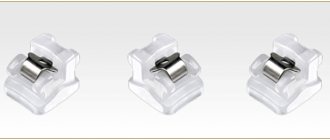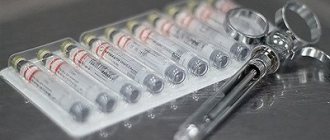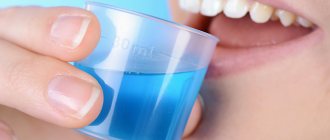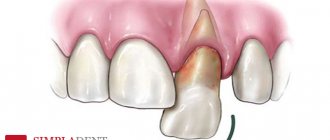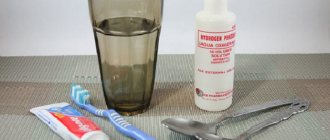When will it be possible to remove braces from my teeth?
To change the position of the teeth in a row, you will have to wear braces for quite a long time - at least several months, but positive changes will appear much faster. By assessing the results of treatment with braces, the orthodontist will be able to indicate to you the expected completion date of the bite correction course.
The timing of treatment will depend to a certain extent on you: if you want to remove braces from your teeth as quickly as possible and at the same time acquire a beautiful smile with straight teeth, you must strictly follow all the orthodontist’s recommendations and not miss visits to the clinic to monitor the results of the correction.
Calculate the cost of treatment by taking a short test in 20 seconds!
Do not delay your treatment, because in this matter time plays against us.
When is it time to remove braces?
Typically, the duration of wearing braces depends on the severity of the pathology and the age of the patient. The more complex the clinical case and the older the person, the longer it takes to straighten the teeth. However, the first changes are noticeable within a few months after fixing the system. When it is clear that it is time to remove the braces, the doctor will inform you about the expected end date of treatment.
The process of correcting the bite can take from several months to 2 years. An experienced and highly qualified orthodontist is able to select the most optimal correction scheme that allows you to achieve your goal in the shortest possible time. If you strictly follow all the instructions, the day when you need to remove your braces will not be long in coming.
Removing braces: how to remove the orthodontic structure
Where can braces be removed and how will the procedure take place? These questions concern many people undergoing orthodontic treatment or just preparing to wear braces. Many people think that it is painful or unpleasant, or mistakenly assume that they can remove braces themselves, at home. In fact, it is impossible to remove braces without visiting an orthodontist’s office. This is a simple and non-painful procedure, so there is no need to be afraid of it. To remove braces from your teeth, the doctor will not have to perform any complicated actions; the removal process will go through quite quickly. Lingual braces are removed within an hour, conventional vestibular braces are removed even faster - in 20-30 minutes.
How does the process work? We will describe to you the procedure for removing braces from your teeth in detail. So, to remove your braces, you will go to the orthodontist, and the doctor will do the following:
- Install a retractor in the oral cavity, which will protect the soft tissues of the mouth and mucous membranes during removal of braces;
- Remove the braces system. To remove the structure, the orthodontist will first remove the arches and ligatures, and then the braces themselves.
But simply removing the braces is not enough - after removing the orthodontic structure, be sure to remove any remaining adhesive from the dental surfaces, grind and polish the tooth enamel, and then treat it with a special remineralizing compound.
Removing braces: how to quickly remove the system
The duration of treatment depends on:
- places where the brace system is installed - lingual ones take the longest to remove due to their complex location;
- material - metal plates are the easiest to detach, but fragile sapphire and ceramic systems require accuracy and thoroughness in the approach;
- type of design - the doctor unfastens self-ligating braces without rubber bands faster.
The procedure for removing orthodontic structures from two jaws takes 30-90 minutes, from one - up to half an hour.
Does it hurt to remove braces from your teeth?
One of the common questions from braces patients is: does it hurt to remove braces from your teeth? No, this procedure is painless and can be performed without the use of local anesthesia. Of course, some discomfort during removal of braces is not excluded, but it can be withstood without an anesthetic injection.
If you have a low pain threshold and high tooth sensitivity, warn your doctor about this. Then, before removing the braces, the doctor uses local anesthesia so that the removal procedure takes place without pain or discomfort.
Can I remove braces myself?
One important thing you need to remember is that it is impossible to remove braces safely at home. In order to properly remove braces without damaging tooth enamel and soft tissues of the mouth, you need to have special knowledge, skills, and have dental instruments at your disposal. There are articles on the Internet that tell you how to remove braces at home, but do not follow the instructions given in them: this will not lead to anything good, you can damage your teeth and gums and provoke the development of an inflammatory process.
In addition, removing braces to complete orthodontic treatment is not enough. After the braces are removed, special structures are placed on the teeth - retainers, which secure the result of the bite correction and prevent the teeth from moving apart again. Retainers cannot be bought on the Internet or in a store, and what’s more, they cannot be installed correctly and securely on your own.
It is also impossible to remove the braces yourself because after removing the structure, the glue that was used to fix the plates remains on the teeth. To remove it, the surfaces of the teeth need to be sanded and polished. Remineralization of tooth enamel is also required to restore its structure after wearing braces for a long time.
Why you can’t remove braces yourself at home
Without special knowledge and tools, it is strictly not recommended to remove braces. Today there is enough provocative information on the Internet about removing braces yourself, but you should not follow the lead of unqualified people. Independent intervention can lead to damage to the mucous membrane, teeth, and gums.
Even if you have some knowledge in dentistry, you should not remove braces yourself, because after that you will need to install retainers. It will not be possible to purchase and install correctly without special equipment. Also, without a drill it is impossible to remove residual glue from tooth enamel. Intervention will lead to damage or complete elimination of the therapeutic effect.
If one “lock” comes unglued, you should not remove it yourself. This will cause damage to the structure. It is recommended to visit your doctor as soon as possible, since the failure of one element will lead to a decrease in pressure on the teeth, which will reduce the effectiveness of treatment. If it is not possible to make an appointment, you can temporarily secure the braces with medical wax, which can be found at the pharmacy.
Is it possible to remove braces if the system breaks down?
Braces are durable structures that can withstand heavy loads well. But if the patient does not follow the doctor’s recommendations, the braces may come off. Even under these circumstances, you should not attempt to remove braces yourself! Such attempts may cause you to damage the entire system!
Therefore, there is no need to bother removing braces; your task in such a situation is to get an appointment with an orthodontist as quickly as possible, since the absence of even one element in the system disrupts the balance of the structure and significantly reduces the effectiveness of braces. If you cannot get to the orthodontist in the next day or two, visit the pharmacy, buy medical wax and use it to secure the bracket on the surface of the tooth from which it fell off.
What happens to my teeth after braces are removed?
One of the reasons why braces can only be removed in a dental clinic is the poor condition of the teeth. After removing braces, glue remains on the surface of the teeth; there may be noticeable cracks and white spots formed due to insufficient nutrition of the dental tissues while wearing braces.
It is important to understand that wearing braces negatively affects only aesthetics, but not the health of your teeth. Aesthetic defects will be easy to eliminate: to do this, it is enough to remove the braces, grind and polish the tooth enamel, and conduct a course of its remineralization. Usually these measures are quite enough to completely restore the aesthetics of the appearance of teeth.
But if you want to get the perfect Hollywood smile, then after removing braces, you can put veneers on your teeth, carry out the procedure for whitening tooth enamel, and resort to any other artistic restoration methods.
What procedures will be performed after braces are removed?
Removing braces does not mean ending the course of orthodontic treatment. First of all, the doctor will restore the aesthetic appearance of the teeth.
For this purpose, the following procedures are carried out:
1. Hygienic cleaning. This procedure allows you to remove residual adhesive, tartar and plaque from the surfaces of your teeth. Deposits actively accumulate under braces during the treatment period, and in order to keep teeth healthy, they must be removed.
2. Remineralization of tooth enamel after removal of braces. It is carried out by treating the surfaces of teeth with fluoride and calcium preparations, which saturate the weakened enamel with nutrients and restore its healthy structure.
We wrote above that after removing braces, you can do whitening to get a perfect smile. However, we advise you to remove your braces and wait about a month to whiten your teeth. During this time, the enamel and dental tissues will be sufficiently restored. If you whiten your teeth immediately after removing braces, there is a high risk of tooth hypersensitivity and even pain.
What to wear after braces
The time during which the results of orthodontic treatment are consolidated is called the retention period. The device that the patient will use for final restoration is a retainer or dental mouthguard.
Which system the doctor will tell the patient to use and how long the orthodontist’s prescriptions will have to be followed directly depends on:
- features of bite;
- the severity of the dental anomaly being treated;
- patient's age;
- individual characteristics of the human body.
The retention period most often lasts from six months to two years. It is important to be patient and go through it to the end. Otherwise, all previously achieved results may come to naught.
Why do you need to remove braces and put retainers on your teeth?
Many patients are upset by the fact that it is not enough to remove the braces and complete the course of bite correction: after removing the braces, they will need to wear special structures on the teeth - retainers. Wearing retainers helps to consolidate the achieved positive result in correcting the bite, because if you remove the braces and do not put on the retainers - without the pressure that the brace system puts on the teeth, they will tend to return to their previous position.
Retainers will hold your teeth in the correct position and prevent them from moving. After your braces are removed, your orthodontist may suggest that you install removable or permanent retainers.
Fixed retainers
They are the thinnest wire that is glued to the inner surface of the teeth from the tongue side. Filling materials are used to fix the wire; it will be absolutely invisible to prying eyes and will not cause any discomfort when worn.
Removable retainers
When you come to the orthodontist to remove your braces, the specialist may offer you removable retainers.
These structures can be in the form of thin plates or silicone mouth guards and are worn over the teeth while you sleep. After removing braces, retention mouthguards are made according to an individual impression and their use requires a certain amount of discipline from the patient - if you don’t put the mouthguard on every day and forget about it, you can nullify all the positive results achieved from wearing braces. How long will you have to wear retainers after your braces are removed? Let's answer honestly - the retention period after removing braces is usually quite long; its duration can exceed the duration of the correction course by 2-3 times. And besides, some patients will have to wear retainers after removing braces for the rest of their lives to maintain a beautiful smile with straight teeth.
Where to remove braces in Moscow and how much does it cost?
The removal of the system is carried out by the attending physician in the same clinic where it was installed, so the patient does not have to look for a dentist to carry out the procedure.
With turnkey treatment, there is no need to find out in the capital's centers how much it costs to remove braces, since the service is already included in the final price. In addition, the amount includes the costs of the device itself and its installation. If all stages of bite correction are paid separately, then the cost of removing the device is about 10,000 rubles.
After wearing braces, you will need to put in a lot of effort to maintain a beautiful smile. However, those who have patiently gone through the entire path of bite correction from braces to a retainer confirm that the end result justifies any difficulties of the process!
Will my teeth hurt after my braces are removed?
You need to prepare for the fact that you will experience physical discomfort for some time after your braces are removed. It occurs because the teeth, after removing braces, tend to return to their previous position, and retainers prevent this.
High tooth sensitivity may also occur, explained by the fact that while wearing braces, tooth enamel becomes thinner and weakens. Therefore, pain may occur when drinking hot/cold drinks and food.
The orthodontist must warn you about such side effects before removing braces. In addition, the specialist should advise you in detail on the proper care of your teeth and oral cavity after removing braces and installing retainers.
How to properly care for your teeth and oral cavity after removing braces?
After removing braces, weakened tooth enamel and tooth tissue need time to fully recover. This is why it is so important to ensure proper oral hygiene. It is imperative to undergo professional teeth cleaning and teeth remineralization procedures - they are performed in a clinic and may require several visits to a specialist’s office.
At home, after removing braces, you must regularly and thoroughly brush your teeth, use an irrigator or dental floss to remove plaque from the interdental spaces, and use balms and rinses to prevent gum inflammation. In all these procedures it is necessary to use gels and pastes, which the orthodontist will recommend to you. Usually, pastes with a high fluoride content are prescribed, as well as special remineralizing gels, which are used to treat the teeth after brushing.
Calculate the cost of treatment by taking a short test in 20 seconds!
Do not delay your treatment, because in this matter time plays against us.
Possible complications when wearing structures
As a rule, the orthodontist informs the patient about all the consequences that may occur due to the new system in the oral cavity before starting treatment. Many difficulties are normal for the adaptation period, however, some pathologies require specialist intervention.
The most common problems associated with wearing braces are:
- Sensation of a foreign body in the oral cavity.
A new device in your mouth will inevitably cause discomfort. However, over time, the owner of the system adapts to the new sensations and ceases to feel the braces. Typically, the adaptation period lasts 1-2 weeks after installation. - Pain in the periodontal area.
Unpleasant sensations in some areas of the gums are considered normal. Under pressure, the teeth gradually move into the correct position, which causes pain. This symptom does not appear in all patients and depends, first of all, on the severity of the defect. If the discomfort intensifies, dentists recommend taking a pain reliever. - Headache.
Surprisingly, when wearing orthopedic structures, patients often suffer from headaches. The pressure that the “braces” create on the teeth is transferred to the bones of the skull and acts on the nerve endings, which provokes painful sensations. - Rubbing of the mucous membrane, profuse salivation.
Braces are a foreign object in the oral cavity. The mucous membrane becomes irritated and increased salivation occurs. This phenomenon is also normal, especially if the patient wears bulky structures. In the first weeks, braces can injure the surface of the cheeks, lips, and tongue. - Inflammation of the gums.
A foreign body in the oral cavity can also cause inflammation of the soft tissues. As a rule, special gels, ointments and rinses help eliminate unpleasant symptoms.
To avoid inflammation, dentists recommend using special gels and ointments. An effective remedy that will help to successfully eliminate and prevent inflammation in the oral cavity is ASEPTA gum gel with propolis. The gel has anti-inflammatory, antimicrobial effects against gram-positive bacteria, as well as antipruritic and analgesic effects (reduces pain in affected tissues). The product also accelerates the process of regeneration and epithelization of wound surfaces and stimulates metabolic processes.
If the inflammation was caused by bacteria due to poor hygiene, the patient should definitely consult a dentist. The doctor will conduct a detailed examination of the oral cavity and, if necessary, prescribe adequate treatment.
Other common problems that accompany wearing braces include:
- Impaired diction.
Unfortunately, wearing braces at first inevitably provokes speech impairment. Diction is most strongly affected by lingual structures installed on the inside of the teeth. Over time, the speech defect goes away, and to speed up the adaptation process, patients are advised to read aloud. - Diet restrictions.
The process of correcting your bite inevitably affects your diet. Wearing braces requires avoiding nuts, seeds, soft drinks, and various sticky foods. Improper nutrition significantly reduces the life of the structure. - Unnatural smile.
. Many owners are embarrassed to smile widely, exposing their teeth. The smile turns out to be restrained; the lips cannot cover the increased volume of teeth. - Dry lips.
Those with braces inevitably suffer from excessive dry lips, so after installing the braces, be sure to stock up on moisturizing lipsticks and lip balms. - Caries and enamel damage.
Insufficient and illiterate oral hygiene provokes the accumulation of plaque on the teeth, which, when wearing braces, accelerates the development of caries. Before orthodontic treatment, it is recommended to have your teeth professionally cleaned and have dental check-ups every three months. The enamel structure can also be destroyed by an incorrectly installed system. - Destruction of the upper part of the roots of the teeth.
Due to excessive pressure aimed at moving the teeth, their upper part may be destroyed. Most often, owners of rounded and short teeth suffer from this problem. Such patients are recommended to undergo radiographic examination every six months to prevent the development of pathology. - Incorrect installation of the braces system
and, as a result, injury and inflammation of the gums, as well as various dental problems. - Difficulty in care.
Food debris often gets stuck between the enamel of the teeth and the arches of the braces, so after eating it is imperative to clean the mouth. If a toothbrush or a special orthodontic brush is not at hand, the patient should rinse his mouth thoroughly.
Most modern orthodontic structures are absolutely safe and hypoallergenic. However, if your body exhibits an unusual reaction after getting braces, it is important to see a doctor as soon as possible.
An allergy to braces usually manifests itself as a minor rash in or around the mouth. In rare cases, runny nose, dizziness, and shortness of breath may occur.
Is it possible to remove braces from teeth ahead of schedule?
It is possible to remove braces ahead of schedule only if the process of correcting the bite went faster than initially predicted. But such cases are very rare. More often, the need to remove braces ahead of schedule arises under the following circumstances:
- Conservative orthodontic treatment does not give a positive result. In this case, it is advisable to remove the braces and correct the bite with surgery;
- Braces will have to be removed if the system breaks down or if the patient has an allergic reaction to it.
Other reasons (including special occasions, significant events) are not considered valid for removing braces. Of course, if you insist, the doctor will remove the braces from your teeth and put them on after some time. But at the same time, you will have to install a new structure, and the treatment time may increase significantly. In addition, early removal of braces can have a negative impact on the functioning of the maxillofacial joint.
If you know that after some time a significant event is planned in your life, you lead a public lifestyle - it is best to initially make a choice in favor of aesthetic and invisible types of braces on the teeth - ceramic, sapphire, lingual brace systems. Then the braces will not have to be removed, and you will be able to complete the course of treatment without unnecessary expenses and visits to the clinic.
Early removal
The need to remove the structure before completion of treatment may arise for several reasons:
- Allergy to the material used in the manufacture of braces.
- Wearing it does not have the desired effect.
- Urgent intervention is required due to complications.
- Structural failure due to mechanical damage.
- Replacing one doctor with another.
There are often cases when patients themselves ask to remove their braces for a while so that they would not be seen in this form at a public event. This procedure is possible, but impractical for several reasons. A device that has been previously used cannot be reinstalled. It needs to be purchased and installed again, adjusted to the parameters of the previous one. Because of this, the patient will lose money and time, and will also delay the final result.
The decision to discontinue use is made solely by the dentist, since early removal entails zeroing out the result, and as a result, the teeth will quickly return to their original irregular shape.

